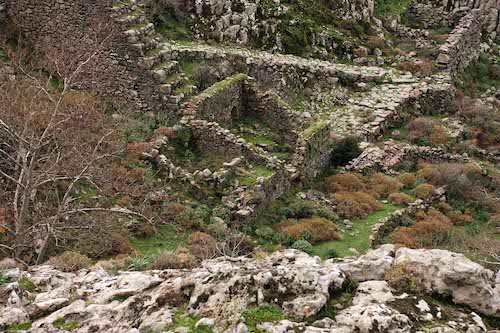It is said that the Chinese invented the watermill, some also say that it was the Greeks. The Greek Philo Mechanicus (or Philo of Byzantium) wrote Mechanike syntaxis in the third century BC. It is a book full of mechanical ideas concerning warfare, toys, secret letters and waterworks. This book also describes a watermill.
There are watermills of all sizes and in all forms. The so called Greek watermill has a horizontal winged wheel with a vertical axle for a strong water supply. The so called Roman watermill has a vertical main wheel, and a horizontal stream of water putting the wheel in motion, like a river.
Lesvos had plenty of mills, most of the Greek watermills hidden against steep mountain slopes, a natural place for the vertical axles. A popular walk for adventurous hikers goes to the Valley of Ligonas, just above Petra — a beautiful place with an entire collection of watermills. Here where the same named river meanders along the ravine to meet the sea, are the remains of 14 to 18 watermills (the number varying amongst the written sources about the mills).
It is an impressive place. Mountain slopes with vertical basalt columns compete for attention with the axles, the long gone mills united with nature. For centuries this place provided flour, until at the beginning of the 20st century the millers were defeated by the steam machines and the industrial revolution.
For the farmers from villages a little more distant than Vafios and Petri (Petra, Stipsi, Lafionas and Molyvos ) it must have been quite a venture to get the grain milled; there were only donkeys for transport. Not far away from the Ligonas Valley is a special rock, Achilliopigada, and it is said that during the Trojan war Achilles docked there: meaning that the sea used to be further inland and the valley more easy to reach. But I don’t think that in those early times there were already mills. They also say that in the Mill Valley plenty of corn was grown and they think that down in the valley there were lively settlements, which included, for the millers, their servants, the porters, donkey drivers and everyone else, a tavern and of course a little church in order to light a candle in thanks for a good harvest.
Along the Lesvorian rivers you may also find the remains of watermills that still have their wheels turning by the fleeing water. The last working mill was in Millelia, where some 15 years ago flour was still milled. Later the impressive wooden wheel and other remains were transported to Ayi Anaryiri, where the wheel still turns and transports water, but no longer grinds any grain. Close to Eressos I also saw the watermill of Krinilou still at work at the waterfalls of Sappho. This mill and its fairy tale kind of a property was for sale some ten years ago.
Also at the waterfall Nichteras, close to Klapados, are the remains of a watermill: no easy place to reach, but totally suitable to grind the grains. Pity the poor donkeys that had to climb in and out of the ravine. But mills and waterfalls do love each other. In the winter when the rivers have filled with plenty of water also in the Ligonas Valley it’s time to enjoy the falling water.
There are more remains of the empire of mills to be seen on the island, like the windmill of Perama at the Gulf of Yera. This mill once helped the tanning industry and is since 1997 an historic monument. The mill however counts just a little bit over hundred years, while the mills at the Ligonas Valley worked for centuries.
On the island there are two museums (in Agia Paraskevi and Papados) where the history of olive pressing is explained. However nowhere can you now find a still working grain mill. There probably used to be more mills than olive presses on the island. The (hopefully) still existing mills in Agia Anaryiri and the one of Krinilou should also become historical monuments, just like that adorable Valley of Ligonas.











